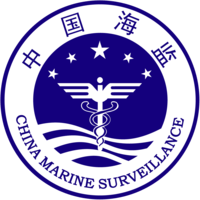Haijian 50
| History | |
|---|---|
| Name: | China Haijian 50 (CMS 50) |
| Owner: | East China Sea Branch, State Oceanic Administration |
| Operator: | 5th Marine Surveillance Flotilla, East China Sea Fleet, China Marine Surveillance |
| Builder: | Wuchang Shipbuilding |
| Launched: | 2011 |
| Commissioned: | June 2011 |
| Homeport: | Shanghai |
| General characteristics | |
| Class and type: | CSA 5/5 Look out vessel, Ice Class B |
| Displacement: | 3980 metric tons |
| Length: | 98 meters |
| Beam: | 15.2 meters |
| Draft: | 5 meters |
| Depth: | 7.8 meters |
| Propulsion: | Azipod (diesel - electric) |
| Speed: | 18 knots |
| Aircraft carried: | Harbin Z-9A |
Haijian 50 is a patrol ship under the flag of the East China Sea Fleet from the East China Sea Branch under the command of the State Oceanic Administration of China, which was commissioned in June 2011. It is the sister ship to Haijian 83 (commissioned in August 2005),[1] and also the parent ship for the subsequent build of five other ships within the same 3000 tonnage class.[2]
History
Haijian 50’s construction started in February 2010 at Wuchang Shipbuilding, Wuhan, China. She was christened and commissioned in June 2011. It is the parent ship, for the subsequent build of five ships within the same 3000 tonnage class, which Wuchang Shipbuilding received an order for in January 2013.[2]
Configuration and equipment
Her length, beam, and depth are 98m, 15.2m, 7.8m, respectively. Her maximum speed is 18 knots; her displacement is 3,980 metric tons; and her range is 10,000 nautical miles.
She can carry a helicopter on a helipad or in a hangar. The default helicopter model is Harbin Z-9.
She has an electrical propulsion system that relies on propellers instead of a rudder for changing direction. Auxiliary propellers give her the capability to rotate in place. She is equipped with a dynamic positioning system that can hold its position even under the conditions of a level 7 wind speed on the Beaufort scale. It carries an onboard desalination system.[3]
Cruise operations
On September 14, 2012, CMS 50 arrived at waters around the disputed Diaoyu Islands and started cruise operations.[4]
References
- ↑ "North Pacific Coast Guard Agencies Forum Summit". China Defence Blog. 15 August 2010.
- 1 2 "WSIC wins US$ 402 mln shipbuilding order". China.org.cn. 18 January 2013.
- ↑ ""中国海监50"号正式履行海洋巡航维权执法职责". 2011-12-13.
- ↑ "中国海监编队近距离靠近钓鱼岛". 2012-09-14.
